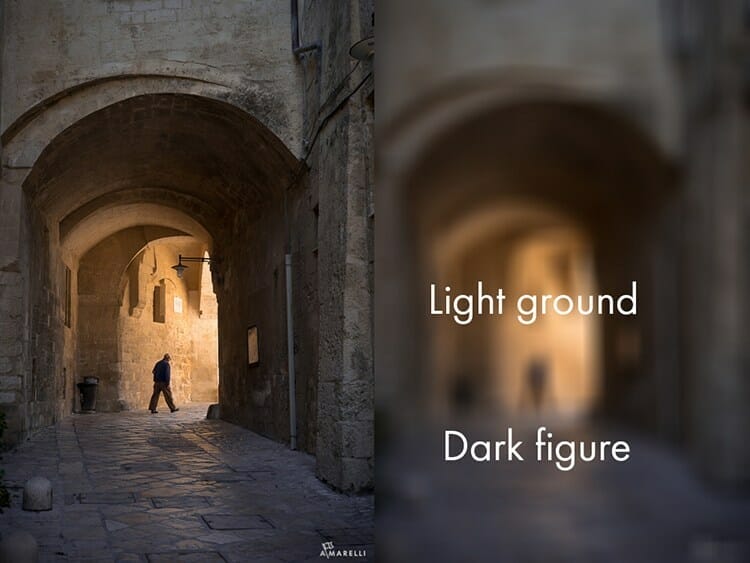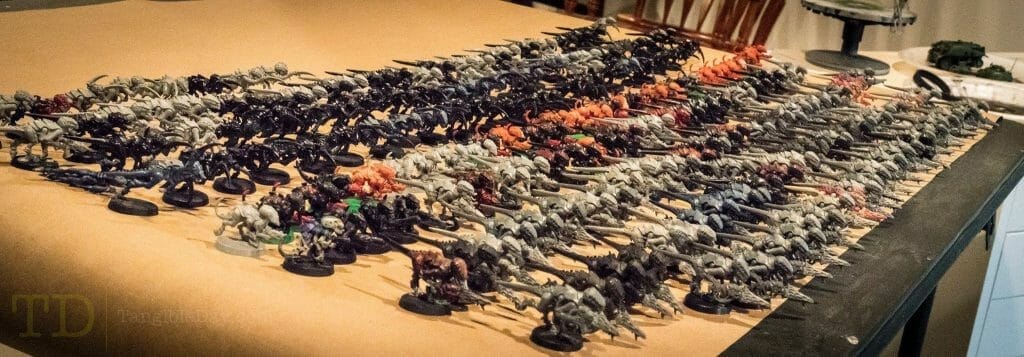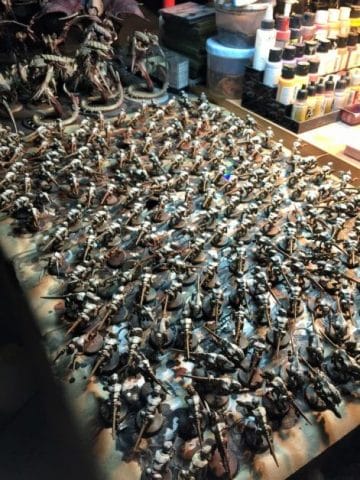Want to paint miniatures faster? Have a horde army collection that still wears bare plastic gray? Speed painting and quality don’t usually mix well. But, with some planning and a few shortcuts, you can get a decent quality paint job on a miniature with little effort.
In this article, I share some of my tips and tricks for getting more painting done.
Is Miniature Painting “Art” and Why is This Important for Speed Painting?
First things first: Miniature painting is art.
“Art is a highly diverse range of human activities engaged in creating visual, auditory, or performed artifacts— artworks—that express the author’s imaginative or technical skill, and are intended to be appreciated for their beauty or emotional power.”
Lumen
As an “art”, painting miniatures is simply the expression and application of human creative skill and imagination (source).

When you speed paint miniatures, all you’re doing is creating art faster. This means that you still need to follow some rules and principles to achieve a desired result. Here are some key concepts you should know and apply whenever you paint miniatures, even if you’re going really fast!
Must-Know Art Illustration Concepts
The foundation for any art piece is understanding the principles of what makes a visual piece interesting and compelling for a viewer.
- Vision
- Contrast
- Figure-to-Ground
If you can incorporate these three illustrative concepts into your project despite how fast you do it, then you’re on your way to being a successful speed painter.
Vision
A painted miniature is a conceptual idea made tangible. A miniature dragon that is flying over a mountain is different than one sleeping in a cave. Can you paint your miniature so that a viewer can clearly envision where it is in space, time, and realm?
Part of your success here is the quality and aesthetic of the bare sculpt (usually pewter or plastic). Before you paint a model with an eye for beauty, ask yourself if the model looks compelling unpainted.
Contrast
A highly-prized painted miniature always has a visual dynamism. What do I mean? A well-painted miniature has a visual tension that pulls you into the miniature’s conceptual space. An artist accomplishes this emotional feat through the use of color (or lack thereof) and contrast (the distance between light and dark value and warm and cool color). Contrast is key.
Numerous painting techniques will help you speed paint a miniature with high contrast. Although your method of paint application can improve contrast, remember that technique is secondary to your goal of completing a speed painted model that achieves the “wow-factor”.
Figure-to-Ground
If you’re a photographer, then you will understand the term “figure-to-ground”. Figure to ground is the relationship between a subject (in this case your miniature), and its environment (the ground). This term has its origin in art theory (source).
Good news: If your speed painting goal is establishing good figure-to-ground, then you don’t need to worry about being a clean painter. You can be messy!

How Do You Add Contrast, Quickly?
Use a wash, quickshade, or dark line paint. You can outline main elements, such as skin from cloth, with these tools and techniques. There are several products that can help speed you up.
Dark Lining Paint (Reaper Master Series)
Reaper Paints have a dark lining paint formulation that will help you quickly “dark line” the edges of major elements of your miniature. This paint will add contrast between shapes and material-types on your model. This darkening enhances a model’s definition.
Dark lining paint is useful for adding shadows to cloth and fast glazing. Lastly, dark lining paint dries matte like other Reaper Model paints, which provides you with a micro-contrast, e.g., visible fine texture under poor lighting conditions.
Citadel Shade Paints
Citadel Shade Paints are one of the most popular products we use as miniature painters to enhance contrast on miniatures. You can purchase Citadel shades in a variety of colors to match the base paint colors on your model.
All of the Citadel shades dry evenly on a model without splotching, if you don’t dilute them with water. In fact, all Citadel shades work best if they are applied straight from the pot. Just make sure shake or mix your paint pots before you use them.
Army Painter: Quickshade
Army Painter Quickshade is perfect for painting bulk loads of miniatures! Add contrast fast by dipping speed painted models into the shade. See example picture below for a step-by-step

My results using the Quick Shade approach are fantastic, especially for board game miniatures. Speed painting Zombicide? The Army Painter Quick Shade approach is awesome.

3 Tips for Painting Models Fast
- Paint with a simple color palette
- Use an “assembly line” workflow
- Choose the best tools for the job
1. Paint with a Simple Color Palette
If you don’t have a reference photo available, such as the box art, then don’t try and incorporate too many colors into your miniature painting. Keep it simple.
Games Workshop models are some of the easiest to paint, because they don’t require a lot of colors to look good. The company has tailored the Citadel paint line for this simplicity as well.
Tip #1: Choose 5 colors maximum
The best tip for speed painting is to keep your palette clear of excessive color choices. The number one thing that slows people down is having too little or too many choices. Remove choices by limiting your color palette.
RELATED: A DRY PALETTE CAN HELP YOU PAINT FASTER
Tip #2: Use a warm color, a cool color, two neutral colors. Then, choose an accent color that ties the miniature together.
Remember that your goal is to incorporate vision, contrast, and good figure-to-ground into your painted miniature. You want to do this quickly. The easiest way is to add contrast through dark and light color choices, and a consideration of “temperature”.
What is “contrast” and what does it do in miniature painting?
Contrast is the distance between light and dark value and warm and cool color.
For example, if you’re painting a trooper model from World War 2, there’s green as the main color. The green might be dirty, grundy from the mud and dirt from the battlefield. This would give that green tone a “darkness” and a “warmth”.
So, add another color to contrast this green with, such as a blue-toned backpack or boots, or a deep purple shadow color in the folds of the cloth.
When you’re looking to improve your figure-to-ground (the ability to distinguish the model from its environment), adding contrast is the fastest way to do this.
Additionally, basing the model with a contrasting color tone helps as well. For example, if your miniature is a lighter tone, then add a dark mud or asphalt looking surface.
Tip #3: Remember, if you can keep your miniature painting approach simple and maintain high contrast (with light/dark and warm/cool colors), you can be a bit messy.
Speed painting is often messy. But, if you keep your approach simple (e.g., not too many colors), and maintain high contrast, you will find that being messy is okay!
Speed painting successfully is embracing a different way of thinking.
Everyone will have a preference for their best workflow when it comes to speed painting.
2. Use an “Assembly Line” Workflow
I’ve written about ways I stay motivated to paint large numbers of miniatures. Sometimes your army collection gets too large, and you slip into a painting rut.
The assembly line painting method is a proven way to avoid the tedium of trying to paint a single model at a time to full completion.
In fact, historically, Henry Ford invented the assembly line as a way to increase the productivity of his car factories (this is a fascinating read). Follow Mr. Ford’s innovation and setup an assembly line.
Tip #4: Paint your models faster with a factory mindset.
I use multiple Citadel Painting Handles to accomplish my assembly line. There are many types of ergonomic handles designed for painting miniatures.
I might setup a painting assembly pipeline with multiple models of different genres. I might jump across a Games Workshop 40k Space Marine, a Warmachine Warjack, and an Age of Sigmar Skaven model.

In any single painting session, I’m probably applying paint on 3-6 different models. With a bit of minimal color planning (see above) and a nicely prepared wet or dry palette, this isn’t too difficult.

You could also paint a full unit of the same model this way. Setup your first color and exhaust it before you move onto the next.The great part is that the normal stop and go between models also creates a flow, wherein blocks of time alter between rest and work. Good flow leads to better productivity, because each action is honed and deliberate.
Take an assembly line approach: apply one paint color at a time across multiple models.
3. Use the Best Tools for The Job
This is actually the most important consideration you, if you want to paint minis faster. Your tools must be perfectly suited for the job.
Do you remember when I mentioned that “too many choices can slow you down”?
The right tools also means keep the number of tools you paint with few. No gimmicks either. Don’t listen to the marketers who promise a tool that can do-it-all.
At the end of the day, the best tools for speed painting are the ones you’re most familiar with (more about this below).
Best Tools for Speed Painting Miniatures
Here are 6 miniature painting tools I strongly recommend if you’re looking to paint miniatures fast.
- Glaze ceramic palette
- Dry brush(es)
- Airbrush
- A big brush (the workhorse)
- Good, frigging acrylic model paint
- A hair dryer!
Here is why these are the essentials for painting miniatures more efficiently.
1. Ceramic Palette (glazed)
Use a high-quality glazed ceramic palette. Ceramic glazing keeps the surface smooth and easy to clean. Kind of like a toilet bowl! A glazed dry palette will help speed up your painting by forcing you to paint with only 1-2 colors at a time. You can even play this metagame: How much paint can I apply before the paint on my palette dries out?
Because a dry palette with deep round wells keeps paint in one place, you’re also able to predict how paint will behave. Unlike a wet palette, paint mixed or deposited in a dry palette won’t thin out and lose its consistency.
2. Dry Brush (cheap cosmetic brushes are great!)
Dry brushing is a technique used to highlight raised texture on a miniature’s surface. In general, dry brushing will speed up your painting workflow, because it adds contrast (via highlights) without the need to manually paint each raised surface. Any brush can make a good dry brush, as long as it has the following traits:
First, the brush won’t fall apart with vigorous brushing across a miniatures (e.g., a dry brush method uses friction to apply paint). Second, a good dry brush is usually made with hair tufts comprised of hog hair or synthetic filaments. These materials can withstand the abrasive action of dry brushing (the different types of bristles are described here). Finally, an ideal dry brush has a relatively large belly and broad surface tip to hold and apply dried pigments. This helps to keep your application consistent over several brushstrokes. Old makeup brushes or worn out brushes in your collection can be recycled into dry brushes.
3. Airbrush (get the best you can afford)
An airbrush is the best or worst tool for speed painting miniatures. Airbrushes can speed up your painting, but require more technical skill even for simple base coating, and take time to clean-up and maintain. The cost-effectiveness of an airbrush for speed painting depends on how well you can operate the tool.
I would recommend any double-action, gravity-feed airbrush with a 0.3mm or greater sized nozzle. Remember that you’ll need a reliable air compressor that can deliver a consistent 35 PSI or lower airflow. A moisture trap or air tank will prevent condensed water from disrupting your paint application.
A great purchase for any starter looking to grow with their airbrush would be a Badger Patriot 105 airbrush with an accompanying air compressor (see this article about airbrushing miniatures). Like most products for our hobby, you get what you pay for. Good tools generally help you paint faster, not better. Consider using an ultrasonic cleaner to help you clean your disassembled airbrush parts.
4. The Biggest Brush (the one you fell in love with)
Okay, did you know brushes are like people? You form a relationship with brushes after working with them for a while. They all have their nuances and the better you understand this, the faster you will paint with them.
The best brush for your painting style, speed painting or not, is personal. My favorite workhorse brush happens to be a Games Workshop Citadel Medium Base brush or an Army Painter Regiment brush. Both of these paint brushes hold a lot of paint, applies color reliably, and I’m able to paint small details in a pinch. Of course, I’m only able to say this, because I’ve logged hundreds of hours working on commissions projects with these brushes.
Bottomline: the more you use a single brush, the faster you will become with that tool.
5. Good Acrylic Paint
What is the best paint for speed painting? Speed painting miniatures requires that you apply color quickly. Fewer coats required to achieve good coverage means a faster paint job. This means using paint formulated for miniatures that contain high density, excellent quality pigments.
My favorite paints for achieving quick, efficient model coverage include: Citadel Base paints, Reaper Master Series HD paints, and Scale 75 colors. Similar to brushes, choosing the best paint for speed painting is personal. It’s up to your painting style and preferred method. Remember, the use of a high-density pigmented paint means that you may need to thin your paints.
6. A Hair Dryer (make paint dry faster)
Did you know that a majority of your time painting is waiting for wet paint to dry? If you want to paint faster, you need your paint to dry faster. You don’t need an expensive hair dryer, but look for one that has variable heat modes. Point your hair dryer at a model and operate at a minimum distance of about 2 feet. Any closer and you risk blowing wet paint into areas that you don’t want it to go. I personally use a Conair 1875 hair dryer. A hair dryer is indispensable if you want to speed paint miniatures.
Summary
3 Tips to Painting Horde Armies (Speed Painting Tricks)
- Paint with a Simple Color Palette
- Use an “Assembly Line” Workflow
- Choose the Most Effective Tools
If you want to paint miniatures faster, simplify your color palette, use an assembly line approach, and choose your tools wisely.
I should emphasize that you shouldn’t over-think how to paint your models.
Over-planning can slow you down, too!
I personally find that if I just relax and enjoy the process, I enter into a flow of work that keeps me moving at a nice clip.
That also means I don’t take myself too seriously and remind myself why I’m painting these miniatures.
Happy painting!!!
Do you have a lot of miniatures and models to paint? Do you have any other suggestions for painting miniatures faster? Let me know with a comment below!



